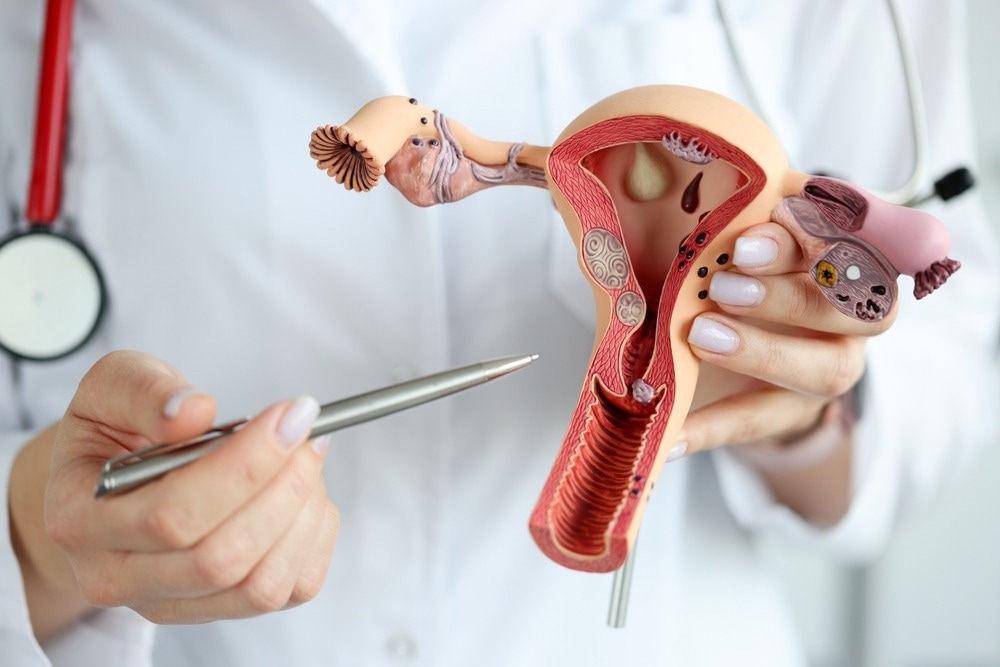In a recent study published in Scientific Reports, researchers evaluate the efficacy of using a product comprising lactic acid (LA), grape seed extract (GS), and pea protein (PP) in managing Gardnerella vaginalis (GV)-induced bacterial vaginosis (BV) in vivo.
 Study: Effect of a combination of pea protein, grape seed extract and lactic acid in an in vivo model of bacterial vaginosis. Image Credit: H_Ko / Shutterstock.com
Study: Effect of a combination of pea protein, grape seed extract and lactic acid in an in vivo model of bacterial vaginosis. Image Credit: H_Ko / Shutterstock.com
Background
BV, a commonly observed bacterial vaginal infection, is characterized by vaginal irritation and foul-smelling discharge. Vaginal microbiome dysbiosis underlies BV pathophysiology, with previous studies reporting GV involvement in BV.
Standard BV therapy involves oral or intravaginal administration of antimicrobials, such as clindamycin, metronidazole, and tinidazole. Given the increasing rates of antimicrobial resistance and BV recurrence, alternative therapies are urgently needed.
About the study
In the present study, researchers evaluate the therapeutic efficacy of a product comprising LA, GS, and PP in managing BV using a GV-induced BV murine model.
GV suspension, which consisted of 1.0 × 106 colony-forming units (CFU)/20.0 µL of saline, was administered intravaginally and GV proliferation was assessed. The effect of LA, PP, and GS on GV adhesion in vaginal tissues was evaluated, followed by histological examination of product-mediated protection against GV-induced damage in the vaginal tissues.
Vaginal tissue architecture parameters for assessment included thickness of the epithelium, polymorphonuclear cell infiltration, and edema. The histological slides were examined by a pathologist who was blinded to the study groups.
Further, the efficacy of the product in reducing myeloperoxidase (MPO) and sialidase activity of GV infections was assessed using vaginal tissue homogenates and vaginal washes of GV-infected mice, respectively. Product efficacy on GV mucoadhesion to the vaginal tissues was evaluated using everted vaginal sac assays.
GV infections were classified as follows:
- Absent (score 0): Zero yeast elements observed.
- Mild (score 1): Between one and 30 yeast elements were observed in the cornified epithelial layer and lumen of the vaginal tissues, or five or less in the upper one-third area of the vaginal mucosal region.
- Moderate (score 2): Between 31 to 60 yeast elements present in the cornified epithelial region and lumen of the vagina, or more than five in the upper two-thirds vaginal mucosal region.
- Severe (score 3): Greater than 60 yeast elements present in the lumen and cornified epithelial region of the vagina, or more than five throughout the mucosal layer of the vagina.
Study findings
The product comprising GS, LA, and PP significantly reduced GV proliferation. In fact, this treatment preserved vaginal tissue architecture and decreased the infiltration of neutrophils, inflammatory marker expression, and sialidase enzymatic activity when used prior to or post-treatment. The product also demonstrated robust bio-adhesion to the mucosal layer of the vagina.
The use of this product was found to significantly decrease the growth of bacteria in vaginal tissues before and after treatment as compared to the Gardnerella vaginalis-infected mice group due to its mucomimetic barrier-forming abilities for protecting the vaginal tissues. Of note, product efficacy was greater when used before treatment, with a 36% reduction in bacterial counts, than when used after treatment, which provided a reduction of 11%.
Upon histopathological examination, no statistically significant differences were observed between the groups. However, the reduction in histological scores was more prominent among pre-treatment mice as compared to the after-treatment group of mice.
Furthermore, the product significantly diminished MPO activity when used pre-treatment; however, it also reduced the activity of this enzyme post-treatment. Similar findings were obtained regarding product efficacy on sialidase activity, with remarkable enzyme inhibition one hour prior to Gardnerella vaginalis infection.
The product showed significant binding percentages of 41% and 50% in the absence and presence of GV infections, respectively, as compared to controls. Thus, robust adhesion of the product to the vagina mucosa was observed and suggests a mucosal barrier protective function.
Pre-treatment with the product was found to decrease GV engraftment, whereas post-treatment use represented an impediment to GV colonization in the vagina. Thus, this product could prevent bacterial invasion and growth when used as preventive or curative therapy for managing BV.
Conclusions
Overall, the study findings demonstrate that the product comprising LA, PP, and GS provided barrier protection to the vaginal mucosa and could be considered as a potential BV treatment to restore vaginal mucosal integrity and pH. One of the key advantages of natural treatments is that they could significantly reduce the risk of antibiotic resistance that is associated with traditional treatments.
The integrative effects of GS, LA, and PP could improve the understanding of BV and support the development of new therapies capable of modulating vaginal infections to ultimately reduce symptoms and infection severity among BV patients. Further research is needed to elucidate mechanisms of restoring vaginal microbiome balance by the product constituents and assess product efficacy in bacterial dysbiosis in vaginal tissues caused by Mobiluncus, Prevotella, Neisseria gonorrhea, and Chlamydia trachomatis.
Journal reference:
- Lanza, M., Scuderi, S.A., Capra, A.P. et al. (2023). Effect of a combination of pea protein, grape seed extract and lactic acid in an in vivo model of bacterial vaginosis. Scientific Reports 13(2849) doi:10.1038/s41598-023-28957-7